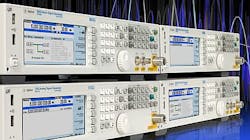Agilent offers test improvements to MXG and EXG X-series vector signal generators
SANTA CLARA, Calif., 17 May 2013. Agilent Technologies Inc. in Santa Clara, Calif., is introducing several key enhancements to its MXG and EXG X-series vector signal generators to improve measurement accuracy, accelerate research and development, and provide in-depth signal simulation for receiver verification.
These enhancements make these test & measurement systems suitable for component and receiver development in radar, military communications, and consumer wireless applications.
The enhanced MXG and EXG X-series RF vector signal generators enable users to apply channel corrections to their fixtures and devices under test. A proprietary ASIC, in concert with an Agilent USB power sensor, enables automatic amplitude and phase flatness corrections or equalization. This industry-first capability is suitable for engineers working on WLAN 802.11ac or LTE-Advanced transceivers and components.
Two X-series connectivity options enable realistic complex-modulated direct digital stimulus (output mode) and digital upconversion (input mode) using an N5102A digital signal interface module.
This DSIM enhancement enables users to employ realistic complex IQ waveforms, which speeds verification of FPGA algorithms or digital-to-RF performance. A power servo enhancement speeds verification by enabling automatic leveling for external RF amplifiers.
Signal simulation through Agilent X-series signal generators enable receiver verification. Agilent's N7620B Signal Studio software for pulse-building connectivity, for example, has radar verification tests designed to minimize field testing and offer characterization.
Users can capitalize on the X-series sequencing engine to obtain 500-second radar antenna scan patterns. They also can reproduce FM chirp radar signals by capitalizing on the X-series factory channel correction for as much as +/- 0.2 dB amplitude flatness and +/- 2 degrees phase error across the bandwidth support on the MXG and EXG.
Agilent's N7609B Signal Studio for Global Navigation Satellite Systems (GNSS) software has an Beidou real-time mode that enables users to perform real-time, multi-satellite simulation for China's Beidou system.
Capitalizing on the X-series real-time baseband subsystem, users can simultaneously simulate a combination of 40 channels of satellites plus multipath for GPS, GLONASS and Beidou, with 16 additional channels for Galileo satellites plus multipath. With the system's ability to model receiver trajectories and map antenna strength, users also can do more testing of multi-constellation chipsets for improved quality of service and performance.
For more information contact Agilent online at www.home.agilent.com.
